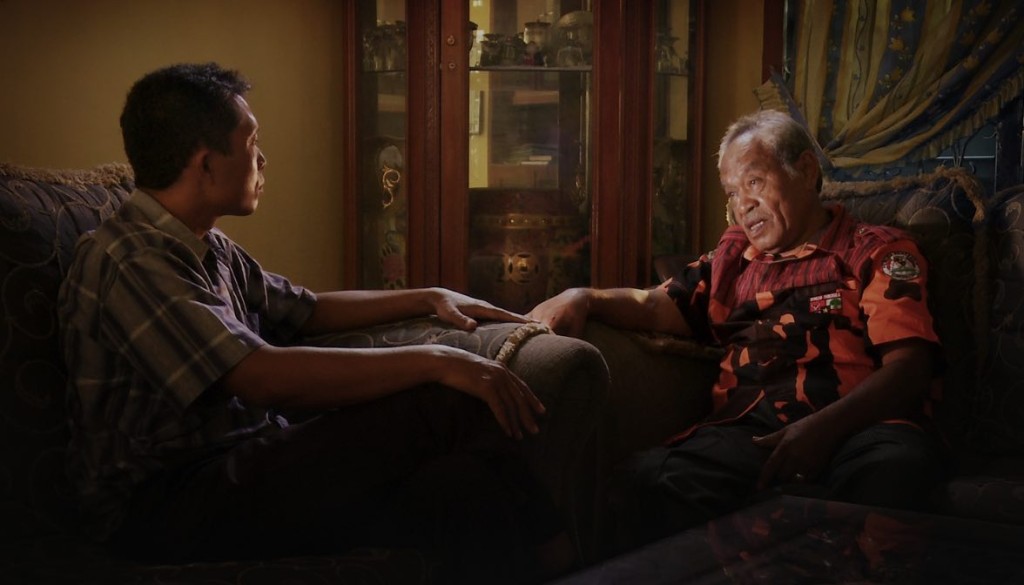In The Act of Killing, Joshua Oppenheimer offered the dramatic testimony of mass murderers as they re-enacted their crimes. In the forthcoming sequel, The Look of Silence, the Oscar-nominated filmmaker brings the perpetrators face to face with the brother of the man they killed.
By Katherine Monk
Joshua Oppenheimer is a precise filmmaker, which is difficult to accomplish at the best of times, but something practically unheard of in documentary. It’s the reason why the Texas-born filmmaker was nominated for an Oscar for his first feature, The Act of Killing, a blend of research and febrile nightmare that related the story of Indonesia’s communist purge in which one million people were murdered.
The movie caused a stir in Indonesia as it showed men who are still in power boasting about their acts of killing, and Oppenheimer suspected it would probably make any repeat visits to Indonesia impossible.
Yet, this month will see the release of a sequel to The Act of Killing with The Act of Silence, recent winner of the Grand Jury Prize at Venice, and what Oppenheimer calls a complement to the first film as it offers another long, disturbingly beautiful look at manmade horror.
The big difference this time is the participation of an optometrist named Adi, brother to one of the murdered men, and now, thanks to the latest film, one of the most important activists in the country.
Adi wanted to confront the men who killed his brother. And he wanted Oppenheimer to film the moment.
The filmmaker’s immediate response was a decisive no. “I said absolutely not,” says Oppenheimer.
“There has never been a documentary in the history of cinema where survivors confront the perpetrators, and where the perpetrators still have a monopoly on power…”
“It’s too dangerous. There has never been a documentary in the history of cinema where survivors confront the perpetrators, and where the perpetrators still have a monopoly on power, so because it’s so dangerous, we cannot do it. And then Adi explained why he wanted to do it: He said it would be the only way his children would be able to escape this prison of fear in which his parents and he had been living. And he had a sense that if he could go and visit the perpetrators, without seeming angry, or seeking revenge, they would welcome the opportunity to be forgiven by one of their victim’s families and to make some kind of peace.”
Oppenheimer paused to reflect on the situation. It was 2012, and he had just finished shooting The Act of Killing, but it had yet to be released. No one knew what the film was really about, only that he had interviewed ministers, governors and some of the most powerful men in Indonesia.
“I had a window in which I could still return to Indonesia… and Adi, who had been working with me for nine years, told me he had been looking at the footage. He said ‘I’ve spent seven years watching your footage with the perpetrators and it changed me. I need to meet the men who killed my brother’.”
Given Adi and several others had been threatened in the very first stages of filming, Oppenheimer knew there was a huge risk.
“I asked the crew if there was any way we could do this, and they said everyone knew we worked with some of the most powerful men in the country on The Act of Killing. But it hadn’t come out yet, so people would believe we were friends with those men. The crew believed they wouldn’t dare attack or detain us,” says Oppenheimer.
And so, one by one, they approached ringleaders and death squad commanders, gained their consent, and filmed the moment of confrontation.
“I recognized that my task was not to follow the words and not to get confessions from all the perpetrators, who have already said what they had done, but to film their inevitably human reactions when confronted with a man who comes and says you killed my brother…”
“I recognized that my task was not to follow the words and not to get confessions from all the perpetrators, who have already said what they had done, but to film their inevitably human reactions when confronted with a man who comes and says you killed my brother,” says Oppenheimer over the phone, shortly before the film’s North American release this week.
“Can you take responsibility? I knew essentially I would be filming people gazing into the mirror of Adi’s question: Looking into this moral mirror and there would be shock, shock of the familiar, but not of the new. We’d see the fear of their own conscience, and all the shame, the guilt, the fear of their own guilt and defensiveness. I felt the reactions, the silences, the shame would really be what mattered in these confrontations, so I studied, as a craftsperson as it were, the work of Ozu and Robert Bresson, to see how to create scenes where everything is being said in the silences.”
The Act of Killing was, in some ways, the exact opposite because it’s all about the actions and the re-enactments, and the moral abdication of the individual in the moment. The Look of Silence is all about the albatross of judgment quietly coming to rest on the shoulder of the guilty.
“In both films, I see myself not as the storyteller who knows what the film will be, but as an explorer — who together with my participants is pushing ever deeper, excavating the vexing problems of the film in deeper and deeper ways,” says Oppenheimer, who recently won the Grand Jury prize in Venice for the new work.
“The Act of Killing was shot over five years and there’s a real evolution in form… that allows the film to make this transformation from observational documentary, of men who are setting about dramatizing what they have done into this kind of fever dream, about where the fiction seems to take over and we are in some completely new territory that maybe hasn’t been explored before in cinema.
“The film is about death but also about love: We’re in this space of grace where it’s about elevating the dignity of these lives through these haunted silences. These landscapes could be shot as banal, but in shooting them with care and precision I am trying to re-haunt the landscape.”
“And in The Look of Silence, I think that I am trying to create landscapes that are haunted. I think the beauty is in the choosing: first of all it gives us a sense of grace and love, that despite all odds, Adi has managed to live within this haunted silence. The film is about death but also about love: We’re in this space of grace where it’s about elevating the dignity of these lives through these haunted silences. These landscapes could be shot as banal, but in shooting them with care and precision I am trying to re-haunt the landscape.”
Deep greens and gurgling freshwater streams stroke each frame, but the testimony is graphic and gory, creating a psychic discordance that Oppenheimer uses to great effect.
“The beauty is part of what makes it disturbing. The beauty and the horror go together. It works slightly differently in each film. In The Act of Killing, it’s the fiction scenes Anwar is making… and I tried to make as close to his vision as possible so it’s undeniably majestic, and so we are transported by the beauty from one fiction dramatization, one fantasy, one lie to the next and I think that’s essential to how the film works, by immersing us in these nightmares,” says Oppenheimer.
 “In The Look of Silence, I am trying to focus on the smallest, slightest traces of a life lived in fear and silence: a wrinkle on a brow, a tiny bean, things that you would normally overlook. And for that, you need a visual precision.”
“In The Look of Silence, I am trying to focus on the smallest, slightest traces of a life lived in fear and silence: a wrinkle on a brow, a tiny bean, things that you would normally overlook. And for that, you need a visual precision.”
From carefully composed tripod shots to ghostlike floaters that seem to linger in thin air, The Look of Silence operates like a visual polygraph – scratching a jagged line across our conscience as we witness the guilty sidestep, negotiate and bargain with their own memory, and their own self-image.
For Oppenheimer, capturing the denial – instead of the truth — was the whole point. “The perpetrators get defensive and deny their responsibility, but in showing it, we could show how torn the social fabric is and how urgently truth and reconciliation are needed.”
Oppenheimer’s hunch was exactly right. The Act of Killing caused international consternation, but The Look of Silence has already screened 3500 times and prompted a truth and reconciliation movement within Indonesia — thanks in large part to Adi.
“He’s become a folk hero,” says Oppenheimer. “It’s taken a team of 25 people to relocate his family to another part of Indonesia… but the film has started this national conversation and helped to prompt the president to apologize to victims. Adi is seen as a national hero, but the fact that he had to move at all, when all he is trying to do is have truth and reconciliation, is a symptom of how far Indonesia still has to go until it has genuine rule of law, and can be genuinely called a democracy.”
The Look of Silence opens in select markets in North America July 24.
@katherinemonk
-30-






No Replies to "The Look of Silence: Joshua Oppenheimer reflects on deflection"